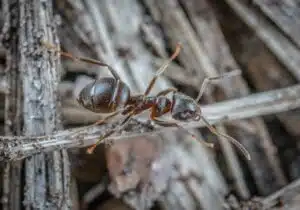Where Do Fire Ants Come From?
The Great Fire Ant Migration
Have you ever wondered where fire ants come from? These pesky little critters can seem to appear out of nowhere, leaving us scratching our heads in confusion. The answer is quite interesting! Fire ants have a long and fascinating history that dates back centuries. Let’s explore the journey of these resilient creatures.
A Brief History of Fire Ants in the US

How Did Fire Ants Get Their Name?
The name “fire ant” comes from their aggressive behavior and painful sting.
Fire ants will swarm and attack anything nearby when disturbed with their powerful mandibles and venomous stings. As if being attacked by thousands of angry ants wasn’t enough, their stings can cause an intense burning sensation that lasts for several hours—hence the name “fire ant.”
The Crazy World of Fire Ant Migrations
To understand how fire ants migrate, it helps to look at their behavior.
When looking for food or nesting sites, colonies will travel up to several miles away in search of what they need. Interestingly enough, these migrations can happen both day and night! Fire ants are so hardy that they can even survive prolonged periods of submersion underwater (up to two weeks!) without any ill effects.
Moreover, when a new nesting site is found, the colony will sometimes send out scouts to determine if the area is suitable for them before moving en masse.
Are There Any Natural Predators of Fire Ants?
Unfortunately, there are few natural predators of fire ants due to their aggressive nature and hardy exoskeleton. In some cases, birds may eat them, or other insects may prey upon them, but these occurrences are rare at best.
In most instances, humans must rely on chemical treatments or baits to control fire ant populations.
Some Helpful Ways to Get Rid of Fire Ants
Fortunately, there are many steps we can take to prevent infestations, such as regularly inspecting our yards for signs of ant activity and promptly treating any infestations with pesticides or other insect repellents.
Additionally, keeping your yard free of debris and clutter can help reduce their numbers since fire ants prefer undisturbed areas with plenty of cover.
Fire ants are an extraordinary species with a remarkable history and the ability to survive in many environments. However, they can be extremely bothersome when encroaching on your home or business.
BUGCO® Pest Control is here to help you get rid of any fire ant infestations and ensure your property remains free from these pesky critters.
Contact us today for a free consultation!
Contact Us
Articles Related to All about Drywood Termites: Nature’s Little Wood-Eaters
-
Property Management Pest Control
December 7, 2023 -
All about Drywood Termites: Nature’s Little Wood-Eaters
January 27, 2023 -
Can Termites Come Back After Treatment?
October 13, 2022 -
Do Termite Bait Stations Work
October 5, 2022





